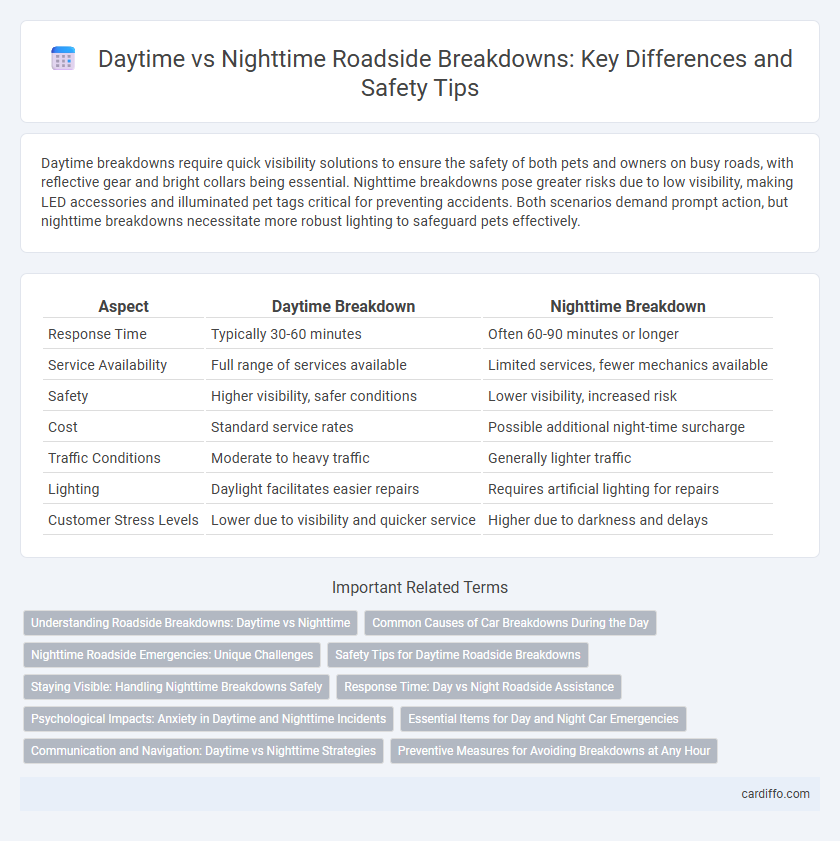Daytime breakdowns require quick visibility solutions to ensure the safety of both pets and owners on busy roads, with reflective gear and bright collars being essential. Nighttime breakdowns pose greater risks due to low visibility, making LED accessories and illuminated pet tags critical for preventing accidents. Both scenarios demand prompt action, but nighttime breakdowns necessitate more robust lighting to safeguard pets effectively.
Table of Comparison
| Aspect | Daytime Breakdown | Nighttime Breakdown |
|---|---|---|
| Response Time | Typically 30-60 minutes | Often 60-90 minutes or longer |
| Service Availability | Full range of services available | Limited services, fewer mechanics available |
| Safety | Higher visibility, safer conditions | Lower visibility, increased risk |
| Cost | Standard service rates | Possible additional night-time surcharge |
| Traffic Conditions | Moderate to heavy traffic | Generally lighter traffic |
| Lighting | Daylight facilitates easier repairs | Requires artificial lighting for repairs |
| Customer Stress Levels | Lower due to visibility and quicker service | Higher due to darkness and delays |
Understanding Roadside Breakdowns: Daytime vs Nighttime
Roadside breakdowns during daytime often present challenges such as increased traffic congestion and reduced visibility caused by sun glare, impacting both driver safety and service response times. Nighttime breakdowns significantly heighten risks due to lower visibility, colder temperatures affecting vehicle performance, and limited availability of emergency services. Understanding these differences helps drivers prepare appropriately by ensuring proper lighting, emergency supplies, and awareness of peak traffic patterns for safer roadside assistance.
Common Causes of Car Breakdowns During the Day
Common causes of car breakdowns during daytime include overheating engines due to higher ambient temperatures, battery failures from excessive use of electrical components, and tire blowouts caused by increased road heat and debris. Daylight hours often see more frequent incidences of stalled vehicles due to fuel system issues or ignition problems triggered by prolonged idling in traffic. Regular maintenance focusing on cooling systems, battery health, and tire condition can mitigate the risk of daytime roadside emergencies.
Nighttime Roadside Emergencies: Unique Challenges
Nighttime roadside emergencies present unique challenges due to reduced visibility, increased safety risks, and limited access to immediate assistance. Drivers are more vulnerable to accidents and misjudgments on poorly lit roads, making rapid response critical for accident prevention. Emergency responders must rely on advanced lighting equipment and heightened alertness to ensure effective roadside interventions during nighttime breakdowns.
Safety Tips for Daytime Roadside Breakdowns
Daytime roadside breakdowns require immediate visibility measures such as activating hazard lights and placing reflective warning triangles at least 30 meters behind the vehicle to alert oncoming traffic. Drivers should wear high-visibility vests to enhance safety when exiting the vehicle and remain on the roadside away from traffic lanes. Keeping a charged mobile phone and emergency contact numbers accessible ensures prompt assistance during a daytime breakdown.
Staying Visible: Handling Nighttime Breakdowns Safely
Staying visible during nighttime breakdowns is critical for preventing accidents and ensuring roadside safety. Use high-visibility reflective vests, deploy bright warning triangles or flares at proper distances, and keep hazard lights on to alert oncoming traffic. Proper illumination and clear signals significantly reduce the risk of collision compared to daytime breakdowns when natural light enhances visibility.
Response Time: Day vs Night Roadside Assistance
Daytime breakdowns typically receive faster roadside assistance response times due to higher availability of service providers and better traffic conditions. Nighttime breakdowns often experience delays as fewer technicians are on duty and reduced visibility can slow vehicle access. Emergency services equipped with advanced GPS and communication technology help minimize wait times regardless of the hour.
Psychological Impacts: Anxiety in Daytime and Nighttime Incidents
Daytime breakdowns often trigger heightened anxiety due to increased exposure to traffic and public scrutiny, intensifying stress levels during peak hours. Nighttime breakdowns amplify psychological distress by inducing fear related to reduced visibility, isolation, and perceived vulnerability in the dark. Both scenarios significantly impact mental well-being, requiring targeted support to address anxiety unique to each time frame.
Essential Items for Day and Night Car Emergencies
Daytime car emergencies require essential items such as high-visibility safety vests, reflective triangles, and a fully charged mobile phone for effective communication and visibility in daylight. Nighttime breakdowns demand additional tools like powerful LED flashlights, extra batteries, and glow sticks to enhance safety and visibility in low-light conditions. Both scenarios benefit from a comprehensive roadside emergency kit including jumper cables, tire repair tools, and first aid supplies tailored to the specific challenges of day or night incidents.
Communication and Navigation: Daytime vs Nighttime Strategies
Effective communication during daytime breakdowns leverages clear visibility to signal distress using hazard lights and reflective triangles, enhancing safety and quick assistance. Nighttime breakdown strategies prioritize illuminated signals, such as high-visibility vests and LED flares, combined with GPS navigation and mobile apps to alert roadside services and accurately share location coordinates. Utilizing smartphone navigation tools optimized for low-light conditions ensures efficient route guidance and minimizes response time both day and night.
Preventive Measures for Avoiding Breakdowns at Any Hour
Regular vehicle maintenance, such as checking tire pressure, fluid levels, and battery health, significantly reduces the risk of breakdowns during both daytime and nighttime. Using reflective emergency kits and ensuring proper lighting improves safety if a breakdown occurs at night. Scheduling routine inspections and addressing minor issues promptly help prevent unexpected roadside failures regardless of the hour.
Daytime Breakdown vs Nighttime Breakdown Infographic

 cardiffo.com
cardiffo.com